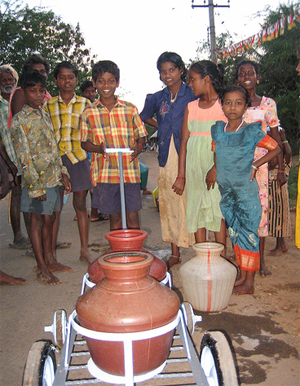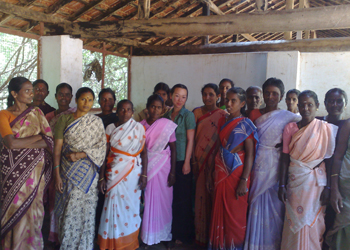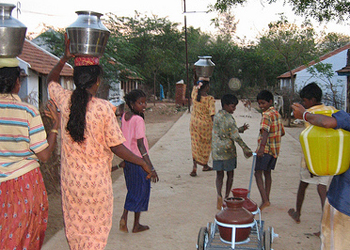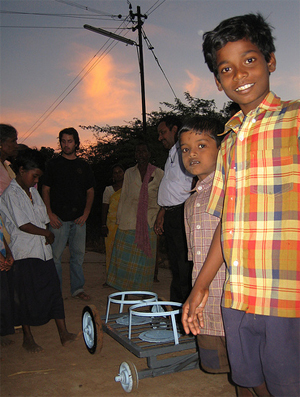Calit2 Researcher at UC San Diego Develops Simple Technology to Help Women in Rural India
San Diego, CA, May 14, 2008 -- For Shannon Spanhake, the idea for a new product came when she picked up one of the ten-liter metal jugs that local women in thousands of Indian communities use to carry water. "I lifted the jug of water and to me, it was heavy," exclaims Spanhake, a researcher in the Univeristy of California, San Diego division of the California Institute for Telecommunications and Information Technology (Calit2).
|
From that realization came an idea: what if a cart on wheels could relieve some of the physical strain of transporting water by hand?
Spanhake mentioned her idea to Dr. V. Sukumaran, a bioengineering professor at Periyar Maniammai University and a local dignitary who is part of Periyar PURA, an effort promoted by former Indian President APJ Abdul Kalam to bring urban amenities to poor rural areas. Sukumaran thought the proposed water cart was a good idea and agreed to work with the UCSD researcher to build a prototype.
Working with Dr. Sukumaran and women in the village of Muthuveerakandianpatti, Spanhake -- an engineer with an MFA from UCSD's Visual Arts department -- helped design and build the first prototype of a MuthuCart. (Muthu, derived from the village's name, also means "pearl" in the Tamil language.)
In keeping with Calit2's focus on 'co-design' in developing markets -- developing technologies with the active collaboration of local communities that will use the eventual products or services -- Spanhake and Sukumaran approached local leaders and villagers of Muthuveerakandianpatti with the prototype. "Before seeing the prototype, some men thought it might be against the way the women socialize. One man was opposed because he said his wife carries the water as a form of affection," recalls Spanhake. "Even some women were skeptical. But when they saw the prototype and realized that it could be a way to generate income, both men and women were excited."
|
In addition to Dr. Sukumaran, Spanhake enlisted the help of structural engineers at nearby Periyar Maniammai University, which builds carts for other purposes and modified an existing model. The university's Vice Chancellor, Dr. N. Ramachandran, made other faculty available to help with planning and building of the water cart, including Dr. K. Rajendran from the Bio-Tech department and other faculty from the Civil Engineering department.
|
The prototype is made of steel, but bamboo and twine, which are available locally, are being explored for construction materials. "We talked to local women about the larger idea of building the next prototype out of local materials so they could eventually build the carts themselves and sell the finished product to other villages," says Spanhake. "Everyone got excited over this idea, so we decided that we need to build reproducibility into the design of the MuthuCart."
|
"The idea is to create an opportunity to let village women use this technology but also to generate income from it," says Spanhake. "Women could run the business, and kids could carry the water. It's a completely different model."
"When we were talking to a women's self-help group in another village in the Periyar district, the women identified water, employment and autonomy as the three biggest issues they face," the researcher adds. "The MuthuCart in its final form will hopefully help rural women on all three fronts."
According to Sukumar Srinivas, Calit2's manager of the India Initiative in the UCSD division, "Calit2's role is both as an innovator and as a facilitator, being able to bring these resources together." To that end, he and Spanhake are meeting with business schools in both countries to explore a new business model for the production, sale and use of the MuthuCart, and Calit2 researchers will continue to work with Periyar Maniammai University and local schools of design on the next prototype.
Related Links
Photo Gallery
Periyar Maniammai University
Media Contacts
Doug Ramsey, 858-822-5825, dramsey@ucsd.edu




